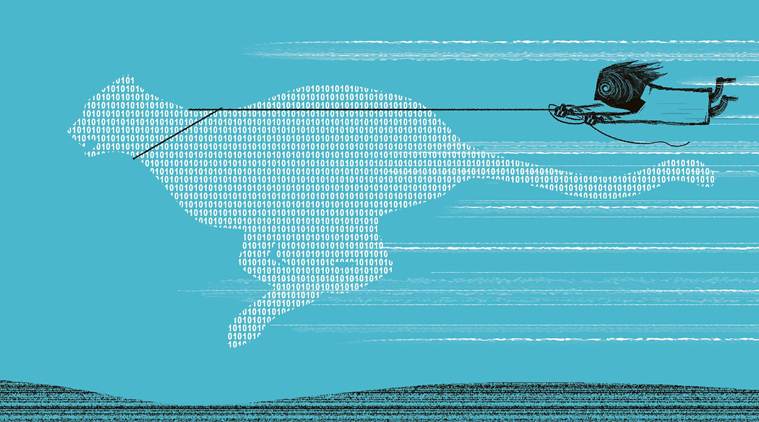The end of digital history
The digital planet’s high points — US, Europe, India — are losing ground to China.

India’s hill climb has always been a more complex one to describe. It has people, poverty and phones resident in a noisy democracy. (Illustration: CR Sasikumar)
One of the digital planet’s many pleasures is that it has many distinct mountaintops. Different locations have offered different advantages: The US, Europe, China and India. But that era might be coming to an end. We may be en route to digital unipolarity as all the others cede the high ground to China. Chances are, we are witnessing a phenomenon I shall call the end of digital history. Here, I take a page from Francis Fukuyama, the political scientist, who wrote in 1989 about the “end of history” — the collapse of the Soviet Union signaling convergence to a singular political order, as exemplified by Western democracies. If history were the process by which liberal institutions become universal, one could say we had reached its end, according to Fukuyama’s logic. Similarly, if digital history were the process by which we converge towards a technological utopia of algorithmic efficiency, social order and productivity, then we might be approaching this end as well. This time the end-state might be one exemplified by an emerging China.
Let’s first take a quick tour of the world’s digital topography thus far. The US, of course, is the pinnacle of digital innovation. In addition to its free-wheeling spirit, it is abundant in dorm rooms and garages, and college dropouts who abandon the former for the latter. It also has many venture capitalists eager to throw money at a college dropout as long as every other venture capitalist is doing the same. Europe, on the other hand, has always been the place where people have a healthy respect for history: Cathedrals and cobblestones over “smart” streetlights and self-driving cars. The Europeans could be relied on to ensure that we didn’t let all this delirium about innovation overtake an old-fashioned concern for privacy and placing controls on the wanton generation, consolidation and harvesting of data. By making the early move with a data protection framework, Europe had claimed the privacy mountaintop. At the other end of the planet, China has people, and lots of them. With 800 million of its citizens on the internet, the Chinese are wantonly generating, consolidating and harvesting data. In turn, this data is digital fuel for the artificial intelligence machine that will power China’s ride up to its own mountaintop.
India’s hill climb has always been a more complex one to describe. It has people, poverty and phones resident in a noisy democracy. While its e-commerce potential may be mouthwatering for investors, its true contribution may well be a framework that balances digital empowerment and digital productivity; this is a balance that has proven elusive elsewhere. As the country’s top tech visionary, Nandan Nilekani, has written recently in Foreign Affairs, India’s intent is to give its citizens “technical and legal tools required to take back control of their data”.
Nilekani’s empowerment toolbox has many components: A digital infrastructure designed as a public good; users with ownership of their data; “data fiduciaries” who are consent managers acting in the users’ interest; a “stack”, the world’s largest applications programming interface that would allow developers and entrepreneurs, public and private, to build products and services; Aadhaar, a foundation enabling efficient verification of each user’s identity. With 1.2 billion people signed up to this biometric identity system, India seemed poised to climb its mountain. As with other grand nationwide initiatives, however, the execution fell shy of the vision. The identity database has not proven to be secure and has raised fears of abuse by those in power or exploited for commercial use. It has already failed in several instances, for a host of reasons — from technical difficulties to the biometrics being hard to read.
Was too much being asked of this system? Can privacy, inclusive access to services and productive entrepreneurship co-exist? Noisy democracy that it is, the country turned to the Supreme Court to sort this out, which has now ruled Aadhaar is constitutionally valid, but its mandated use has been split up: Okay for government programmes and tax filings, but not for privately provided services such as banking, phone services or airline bookings.
While one can see the wisdom in this judgment, there is also a sense that the path up the empowerment-cum-productivity mountain just got harder and India’s execution challenges may have become greater. Some users may use Aadhaar to prove identity, while others might not. This could mean a return to long delays and the usual runarounds. Data associated with the user as she moves back and forth across the public-private boundary would be incomplete. For developers and entrepreneurs, this might mean contending with “aadhaa Aadhaar” — a half-foundation for know-your-customer or for running data analytics. For the consumers, there might be confusion about how to de-link Aadhaar from existing private accounts, along with other questions: Does the Aadhaar mandate for one service become a de facto mandate for another because the first service is a pre-requisite for the second? Do private service providers avoid serving those for whom alternative identity proofs are difficult? Does the latest ruling have an unintended consequence of making the private services less inclusive? Have the Supreme Court decisions truly done anything to help with the execution challenges?
As India ties itself in knots, consider China, where the state is assembling its own comprehensive citizens’ database. It plans to create a mandatory social credit system from this data by 2020. Every Chinese citizen’s “social credit score”, using data from multiple public and private data sources, will determine what services — from apartment rentals to dating to government services — are accessible to the citizen. It may not be empowering and may be an affront to civil liberties, but it would be ruthlessly productive. As the rest of the world prays at the altar of digital efficiency tied to identity, it would be hard to look away from a new standard set by China.
India is not alone in ceding its digital high ground. China may set new standards in privacy protection as long as you overlook the notion that the state knows everything. Beijing is reportedly reproducing aspects of Europe’s data protection rules, but it is going further by requiring that its citizens’ data be held within China. Europe, in the meantime, will focus on compliance and regulation and continue to struggle to re-establish an innovative mindset, one it has lost for two decades. Speaking of innovation, China is laying the groundwork for beating the US at its own game. It is creating an innovation corridor with a grand infrastructure plan to bind Hong Kong and Macau with the entrepreneurial southern tip of the mainland; its volume of venture-funding has surpassed that of the US; it produces 4.7 million STEM graduates versus 5,68,000 in the US each year; Chinese-origin authors produce anywhere between a quarter to a third of all scientific papers; and, most importantly, it has a government that plans two steps ahead and a president who has a job for life without the annoying disorderliness of democracy. The US, in the meantime, is struggling to deal with its growing angst about its digital companies and their many foibles while its government has all but abandoned investing in innovation for the long term.
The digital planet’s high points — US, Europe, India — are losing ground to China. Unless governments, visionaries and entrepreneurs in each of these locations wake up and smell the coffee. A digital planet with a mountaintop in a single location doesn’t seem like a particularly exciting place, especially one that works with clockwork precision under the watchful eyes of a central planner. It would be the end of digital history. Francis Fukuyama, the end-of-history prognosticator from 1989, was, of course, spectacularly wrong. His prediction about the victory of the liberal order has not come to pass.
I hope I am spectacularly wrong as well.
The writer is the Dean of Global Business at The Fletcher School at Tufts University, founding executive director of Fletcher’s Institute for Business in the Global Context and non-resident senior fellow of Brookings India.
For all the latest Opinion News, download Indian Express App
More From Bhaskar Chakravorti
- A lynching in Digital SouthThe companies that have got us hooked must be on the hook for better solutions ..
- Growth in the machineIf done right, artificial intelligence can jump-start India’s productivity, help the country get out of the emerging economy trap, propel it into the ranks of…
- One misstep too manyFacebook has egg on its face again and this time it might stick..







































No hay comentarios:
Publicar un comentario